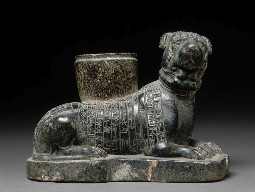Ninisinna (goddess)
Healing goddess and patron deity of the city of Isin.
Functions

A dog statuette dedicated to Ninisinna for the life of Sumu-El, king of Larsa (1894-1866 BCE). Louvre Museum, AO 4349, image © The Louvre Museum.See this object in the Louvre's catalogue.
Ninisinna's primary role was as a healing goddess. She is called "great physician of the black-headed ones", and her medical activities include incantations and more invasive methods – in one hymn she is depicted sharpening her scalpel (ETCSL 4.22.1, line 11). During the Old Babylonian period she acquired some warlike functions, perhaps due to her association with Inana. Here her scalpel becomes a weapon to tear flesh, and she is described as a storm "whose mouth drips blood...from whose mouth spittle spews constantly, pouring venom on the enemy" (ETCSL 2.5.3.4, lines 13-14).
Divine Genealogy and Syncretisms
Ninisinna was the daughter of An and Uraš. She was married to the god Pabilsag, with whom she had a son Damu and a daughter Gunura.
During the early second millennium, she was syncretised TT with the healing goddesses Gula/Ninkarrak, Nintinugga and Baba. She also came to be connected with Inana, probably during the Isin period (2017-1794 BCE) when Ninisinna rose in prominence as goddess of the dynastic capital. This situation is perhaps reflected in Enki and the World Order, where Inana ascribes high status to Ninisinna: "She is to be the mistress of heaven. She is to stand beside An and speak to him whenever she desires" (ETCSL 1.1.3 [http://etcsl.orinst.ox.ac.uk/cgi-bin/etcsl.cgi?text=t.1.1.3#], lines 404-5).
Cult Places
The é-gal-mah temple in Isin [~/images/Isin.jpg] was the heart of Ninisinna's cult. Probably within the complex was é-ur-gi7-ra ("dog house"), built by Enlil-bani (1860-1837 BCE). Ninisinna, like Gula, was associated with dogs, and 33 dog skeletons were excavated in é-gal-mah. Many of the animals were sick or injured, and it is possible that they were cared for by the temple (Avalos 1995). Ninisinna was also worshipped at temples in Larsa [~/images/Larsa.jpg], Babylon [~/images/Babylon.jpg], Ur [~/images/Ur.jpg], Uruk [~/images/Uruk.jpg], and Larak [~/images/Larak.jpg] (George 1993: index s.v. "Ninisinna").
Time Periods Attested
Ninisinna is first attested in the Fara god lists from the Early Dynastic IIIa period . By the end of the third millennium she was receiving cult at Isin and beyond, but the apogee of her importance was during the Old Babylonian period . A number of Sumerian hymns in praise of her survive (ETCSL 4.22.1 [http://etcsl.orinst.ox.ac.uk/cgi-bin/etcsl.cgi?text=t.4.22.1#], ETCSL 4.22.2 [http://etcsl.orinst.ox.ac.uk/cgi-bin/etcsl.cgi?text=t.4.22.2#], ETCSL 4.22.4 [http://etcsl.orinst.ox.ac.uk/cgi-bin/etcsl.cgi?text=t.4.22.4#], ETCSL 4.22.5 [http://etcsl.orinst.ox.ac.uk/cgi-bin/etcsl.cgi?text=t.4.22.5#]), as well as several royal hymns dedicated to her (e.g., ETCSL 2.5.1.4 [http://etcsl.orinst.ox.ac.uk/cgi-bin/etcsl.cgi?text=t.2.5.1.4#] for Išbi-Erra, ETCSL 2.5.3.4 [http://etcsl.orinst.ox.ac.uk/cgi-bin/etcsl.cgi?text=t.2.5.3.4#] for Iddin Dagan, ETCSL 2.5.5.5 [http://etcsl.orinst.ox.ac.uk/cgi-bin/etcsl.cgi?text=t.2.5.5.5#] for Lipit-Eštar). She also appears in city laments (ETCSL 2.2.2 [http://etcsl.orinst.ox.ac.uk/cgi-bin/etcsl.cgi?text=t.2.2.2#], the Lament for Urim; ETCSL 2.2.3 [http://etcsl.orinst.ox.ac.uk/cgi-bin/etcsl.cgi?text=t.2.2.3#], the Lament for Sumer and Urim; ETCSL 2.2.4 [http://etcsl.orinst.ox.ac.uk/cgi-bin/etcsl.cgi?text=t.2.2.4#], the Lament for Nibru), Pabilsag's Journey to Nibru, which recounts her marriage (ETCSL 1.7.8 [http://etcsl.orinst.ox.ac.uk/cgi-bin/etcsl.cgi?text=t.1.7.8#]), and Ninisinna and the Gods, where she is equated with other city goddesses (ETCSL 4.22.6 [http://etcsl.orinst.ox.ac.uk/cgi-bin/etcsl.cgi?text=t.4.22.6#]).
After the Old Babylonian period Ninisinna is rarely attested, surviving essentially as Gula with whom she is equated in lexical texts. Nonetheless the Kassite king Kurigalzu rebuilt the Isin é-gal-mah in her name, and she appears occasionally in first millennium sources, such as a litany from Neo-Assyrian Kalhu (CTN 4, 110).
Iconography
Apart from her connection with dogs, Ninisinna's iconography is unclear.
Name and Spellings
The name Ninisinna means 'Lady of Isin.' Since divine names of the type "lord/lady of GN" are rare, there is some uncertainty as to whether "Ninisinna" represents a 'real' name or a title (Kraus 1951). The value of the sign IN in early writings of her name was subject to controversy, but Steinkeller has convincingly argued that it is always to be read isinx (Steinkeller 1978).
- Written forms:
- Sumerian: dnin-isinx(IN), dnin-isinx(IN)-si-na, dnin-isinx(IN)-na, dnin-ì-si-na, dnin-ì-si-naki, dnin-ì-si-in-na, dnin-EZENki, dnin-EZEN-naki.
- For more spellings see Römer 1969.
- Normalised forms:
- Ninisinna, Ninisina, Nin-Isina
Ninisinna in Online Corpora
- The Cuneiform Digital Library Initiative
- The Electronic Text Corpus of Sumerian Literature
- The Electronic Text Corpus of Sumerian Royal Inscriptions
- The Corpus of Ancient Mesopotamian Scholarship
Further Reading
- Avalos 1995, Illness and Health Care.
- Edzard 1998-2001, "Nin-Isina".
- Kraus 1951, Nippur und Isin.
- Livingstone 1988, "The Isin 'Dog-House' revisited".
- Römer 1969, "Einige Beobachtungen zur Göttin Nini(n)sina".
- Shaffer 1974, "Enlilbani and the 'Dog House' in Isin".
- Steinkeller 1978, "A note on the reading of the name of Isin".
Content last modified: 18 Dec 2019.
Kathryn Stevens
Kathryn Stevens, 'Ninisinna (goddess)', Ancient Mesopotamian Gods and Goddesses, Oracc and the UK Higher Education Academy, 2019 [http://oracc.museum.upenn.edu/amgg/listofdeities/ninisinna/]